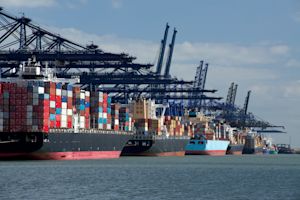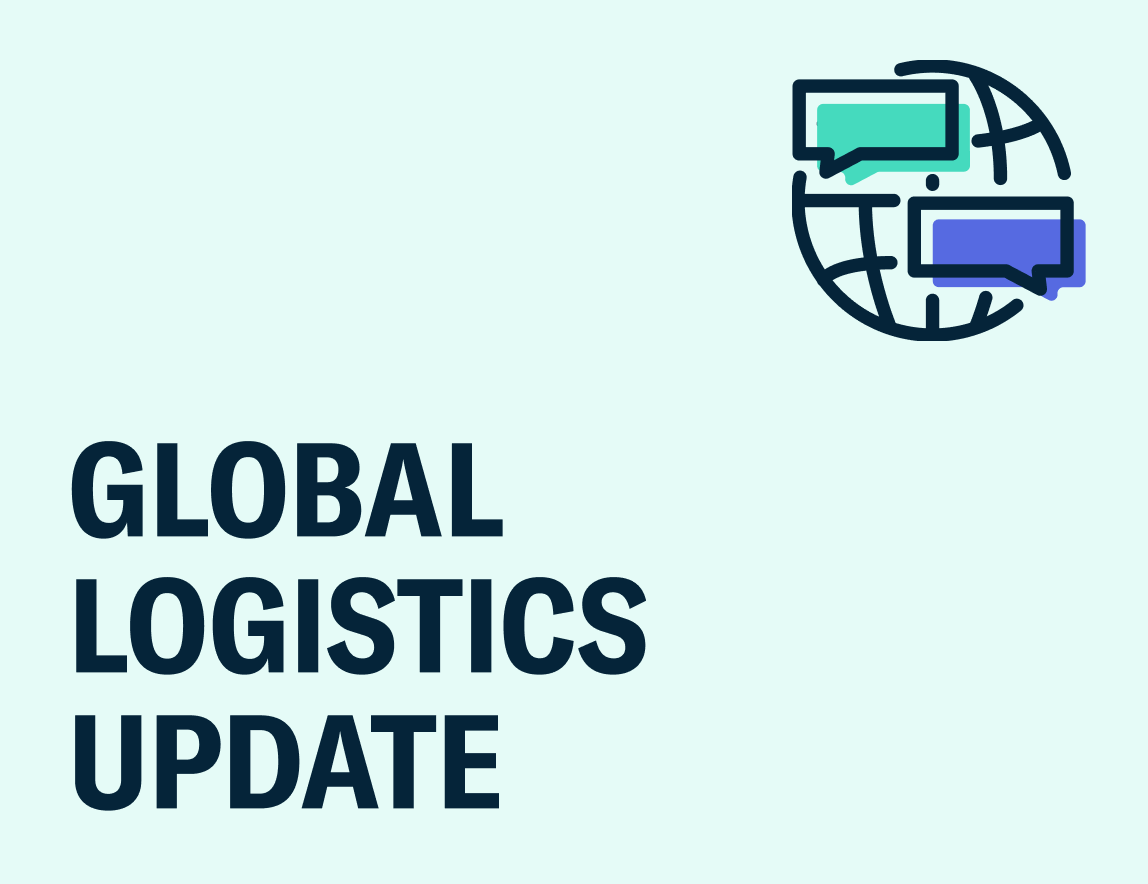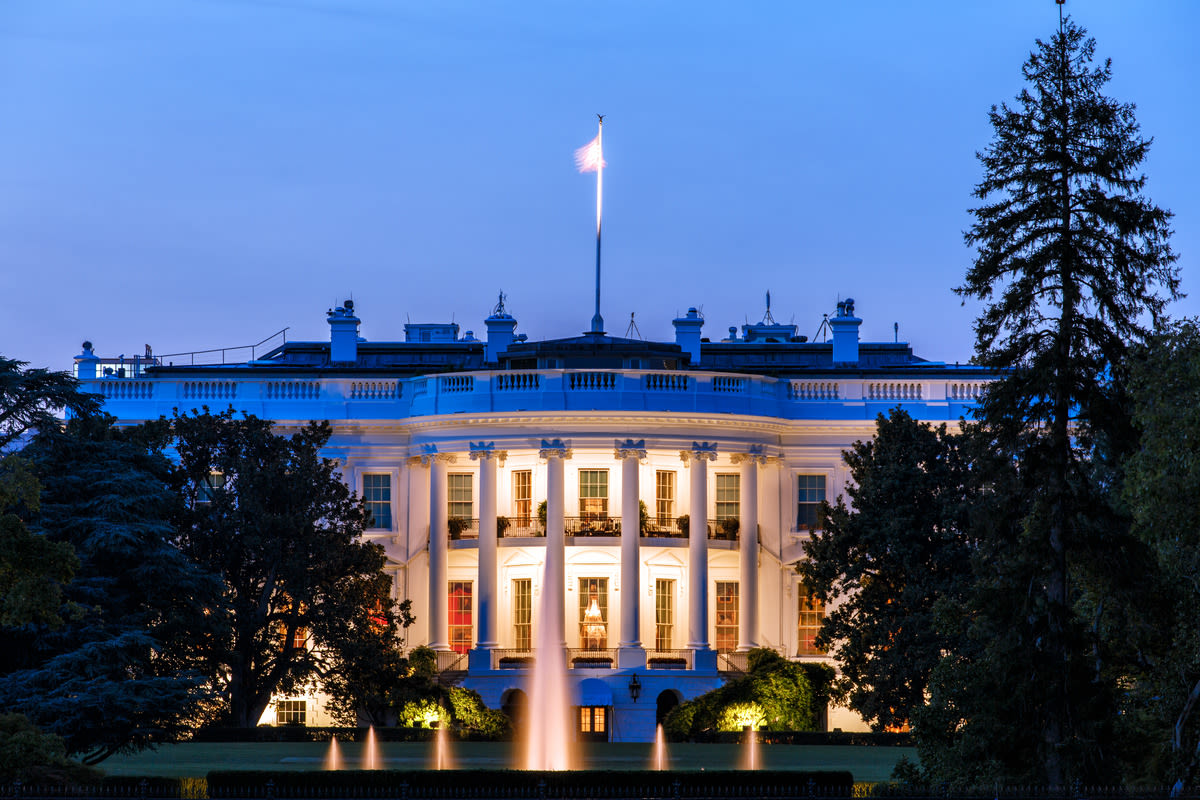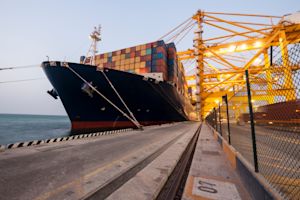
Global Logistics Update
U.S. and China Begin to Implement Tariff Truce Measures; FEWB Carriers Continue to Cut Capacity
Updates from the global supply chain and logistics world | November 13, 2025
Global Logistics Update: November 13, 2025

November 13, 2025
Trends to Watch
Talking Tariffs
- EU to Eliminate Duty Exemptions for Low-Value Goods: The European Council announced today that it had reached an agreement on eliminating duty-free treatment for goods valued under €150, citing unfair competition and environmental concerns.
- Timing: The EU intends to introduce a temporary transitional solution as soon as 2026, and will implement a longer-term solution upon the launch of the proposed EU Customs Data Hub, expected in 2028.
- According to European Commission data, 91% of low-value ecommerce shipments imported into the EU in 2024 originated from China.
- Today’s announcement comes just months after the U.S. officially eliminated its own duty-free exemption for low-value goods.
- Potential Tariff Cuts on Agricultural Products: Yesterday, U.S. Treasury Secretary Scott Bessent stated that the Trump administration plans to announce tariff cuts on certain agricultural goods, including coffee and bananas.
- Brazil, the biggest supplier of coffee to the U.S. last year, currently faces a combined 50% tariff: a 10% IEEPA reciprocal tariff and an additional 40% IEEPA tariff. Other major suppliers include Colombia and Canada, currently subject to 10% and 35% tariffs, respectively.
- U.S. and China Begin Implementing Tariff Truce Measures: The U.S. and China have begun implementing provisions agreed upon during President Trump’s and President Xi’s meeting on October 30.
- On November 9, China announced a one-year delay in the implementation of certain rare earth export controls.
- On November 10, the U.S. reduced its “fentanyl” tariff on China from 20% to 10%, bringing the combined effective duty rate on China to approximately 45%: a 10% reciprocal tariff, a 10% “fentanyl” tariff, and up to 25% in Section 301 tariffs.
- On November 10, the U.S. suspended its recently implemented port fees on Chinese vessels for one year. In response, China has also suspended its retaliatory port fees on American vessels for one year.
- After China purchased its first American soybean cargoes of the season ahead of President Trump’s and President Xi’s October 30 meeting, purchases have reportedly slowed. As part of the recent tariff truce, China agreed to purchase at least 12 million metric tons of U.S. soybeans in the last two months of 2025, and at least 25 million metric tons each year between 2026 and 2028.
- China also agreed to suspend retaliatory tariffs and non-tariff countermeasures against the U.S. implemented from March 4 onwards.
- President Trump Announces Potential Tariff Dividends: In a November 9 Truth Social post, President Trump announced plans to issue a $2,000 tariff dividend to each American, excluding high earners. The proposal would likely require Congressional approval.
- President Trump has yet to specify which Americans would be eligible for the payment, and exactly how and when it would be paid out. Treasury Secretary Bessent indicated on Sunday that tariff dividends could be distributed in a multitude of ways, such as “tax decreases that we are seeing on the president’s agenda.”
- International Emergency Economic Powers Act (IEEPA) Tariff Case: On November 5, the U.S. Supreme Court heard oral arguments on the legality of the Trump administration’s IEEPA tariffs. The Court will likely take at least a few months to reach a decision, and may even announce a ruling as late as the end of its term in June of 2026. In the meantime, IEEPA tariffs will remain in effect.
- Several justices challenged the Trump administration’s assertion that the tariffs aim to “regulate importation” in response to rising trade deficits and a fentanyl-induced public health crisis, questioning whether the tariffs ultimately serve as taxes that generate revenue from American citizens. The Court also raised concerns over the complexity of refunding more than $90 billion in already-collected duties.
- If the Supreme Court rules against the Trump administration’s tariffs, U.S. Customs and Border Protection (CBP) would halt duty collection immediately while implementing a refund process. However, it is unclear how much discretion the court order would give CBP in how it can issue refunds, or if the justices would first determine which importers are eligible for refunds. Additionally, if the Court does strike down the tariffs in question, the Trump administration could potentially turn to other statutes—like Sections 301, 232, 122, or 338—to re-implement those tariffs or introduce new ones.
- If the Supreme Court upholds the tariffs, on the other hand, the case could potentially return to the lower courts for another review of certain aspects of the case.
- Find more details and the latest developments on our live blog.
Calculate your tariff and landed cost impacts in real time with the Flexport Tariff Simulator.
Ocean
TRANS-PACIFIC EASTBOUND (TPEB)
- Capacity and Demand:
- Capacity has bounced back sharply for November following last month’s post-Golden-Week reductions. Capacity is expected to remain at over 80% through November, indicating overcapacity vs. current demand volumes.
- Demand remains stable and flat, with no significant changes observed in response to the previously anticipated November 1 tariff hike on Chinese goods.
- Freight Rates:
- The November General Rate Increase (GRI) has been eliminated until the end of the month.
- Freight All Kinds (FAK) rates remain, but some carriers are offering “specials” at lower rate levels to fill ships.
- Spot rates are continuing to experience downward pressure.
- The Peak Season Surcharge (PSS) was further postponed until December 1. Given the general softening of the November GRI and ongoing overcapacity vs. flat demand, it appears unlikely that a PSS or a high December GRI will fully hold.
FAR EAST WESTBOUND (FEWB)
- Capacity and Demand:
- Severe port congestion in Rotterdam persists. To improve schedule reliability and enhance eastbound service efficiency, carriers have announced that certain voyages will skip Rotterdam. Cargo destined for Rotterdam will be discharged at Antwerp or Le Havre, which may result in arrival delays.
- The second half of November will see a 10% weekly capacity reduction, with only two services blanked.
- Booking demand at origin remains flat. Despite the General Rate Increase (GRI) announced for November, cargo owners are adopting a “wait-and-see” approach. This round of rate increases is mainly capacity-driven, with limited support from demand growth.
- Freight Rates:
- While some carriers are maintaining their GRIs for the second half of November, others are rolling back their GRIs to proactively secure more cargo.
- Shippers are shifting cargo to services with shorter transit times, which has resulted in high vessel utilization on those services. Shippers willing to accept longer transits may be able to find better pricing.
- Overall, general market levels for Freight All Kinds (FAK) rates for the second half of November have seen a 18–25% increase compared to levels in the first half of November, based on current carrier-quoted offers.
TRANS-ATLANTIC WESTBOUND (TAWB)
- Capacity and Demand:
- Antwerp: Yard utilization is at 75%, with berth delays of two to three days. The pilots’ strike has been suspended, but negotiations over pension reforms are ongoing. While further strike action is on pause until at least November 30, backlogs from previous strikes persist, and the strike may resume if the parties involved do not reach an agreement.
- Rotterdam: Yard utilization is at 78-80%, with berth delays of two days.
- Hamburg: Yard utilization is at 75%, with berth delays of five to seven days.
- Bremerhaven: Yard utilization is at 80-85%, with berth delays of one day.
- South Mediterranean (Piraeus, Genoa, Valencia): Significant yard congestion persists, with vessel wait times of three to seven days.
- Equipment:
- Container and chassis shortages remain critical, especially in Austria, Slovakia, Hungary, Southern and Eastern Germany, and Portugal. This has resulted in ongoing operational delays and equipment availability challenges. Southern European ports report fewer issues, but overall tightness in equipment supply continues to challenge cargo flow.
- Freight Rates:
- As of November 11, weak demand is driving down freight rates. Carriers are expected to step up blank sailings, vessel downsizing, and other capacity control measures to prevent further rate drops and protect profitability.
INDIAN SUBCONTINENT TO NORTH AMERICA
- Capacity and Demand:
- Routes from the Indian subcontinent to the U.S. remain in a tariff-escalation-induced status quo. Demand remains soft following August’s tariff escalation, and carriers continue to implement blank sailings to balance supply and demand.
- To the U.S. East Coast: Supply continues to outstrip demand. Carriers have announced blank sailings that are taking effect throughout the month of November.
- To the U.S. West Coast: Capacity remains available, given supply dynamics on the TPEB into the U.S. West Coast.
- Freight Rates:
- To the U.S. East Coast: The market is hovering as is on base lanes. Ongoing carrier capacity management continues to drive more balanced supply.
- To the U.S. West Coast: August’s tariff increases and oversupply on core TPEB lanes are continuing to maintain low rate levels.
Air
- North China:
- Demand continues to rise, driven by both general cargo and strong ecommerce exports.
- The ongoing movement by air of heavy industrial products is limiting available capacity to North America. Recent freighter fleet groundings are also intensifying pressure on capacity. As a result, rates are trending upward, and tight conditions are expected to persist in the coming weeks.
- South China:
- Export demand to North America has remained relatively stable week over week, with a modest uptick in ecommerce and general cargo volumes. Large project and technology-related shipments are also limiting space availability.
- On the Asia-Europe trade lane, the onset of seasonal shopping events has driven an increase in activity, leading to further rate and capacity pressures.
- Taiwan:
- Demand remains strong on both Trans-Pacific and Asia-Europe lanes, largely driven by technology- and AI-related cargo. While additional charter operations have been introduced to help meet demand, capacity remains tight through the end of the month.
- Shippers are strongly encouraged to book early.
- Vietnam:
- Export activity continues to rise, especially on routes to North America.
- Space remains constrained, and shippers are encouraged to place bookings well in advance to secure uplift.
- Cambodia:
- Space availability is limited due to regional holidays and peak season volumes.
- Shippers should arrange bookings at least one week prior to departure to ensure capacity.
- South Korea:
- Demand has softened slightly on North America routes, but remains strong on European destinations.
- Increased volumes on routes to Canada have resulted in space challenges.
- Overall, rates are stable, though limited capacity persists on certain lanes.
- Malaysia:
- Outbound cargo volumes to both North America and Europe continue to grow amid peak season.
- Ongoing capacity constraints are expected to persist through mid-November, with carriers reporting high utilization across main hubs.
- Indonesia:
- Export volumes remain elevated on both major trade lanes, and capacity shortages continue as regional demand intensifies.
- Shippers are encouraged to secure bookings at least seven days in advance to mitigate delays.
- Thailand:
- Market demand is steady, with a slight downward adjustment anticipated after month-end.
- Exporters are rushing to meet monthly targets, driving temporary space constraints.
- Shippers should secure bookings at least one week ahead to guarantee allocation.
(Source: Flexport)
Please reach out to your account representative for details on any impacts to your shipments.
North America Vessel Dwell Times

Webinars
Ocean Market Predictions for 2026
Thursday, November 20 @ 8:00am PT / 11:00am ET / 16:00 GMT / 17:00 CET
Tariff Trends 2025: Expert Insights on the New U.S. Customs Landscape
Watch On-Demand
Ocean Timeliness Indicator
Transit time decreased from China to the U.S. West Coast, stayed near-constant from China to the U.S. East Coast, and increased from China to North Europe.
Week to November 10, 2025
Transit time from China to the U.S. West Coast saw a moderate decrease, from 34.5 to 33.4 days. Meanwhile, transit time from China to the U.S. East Coast stayed near-constant, dropping slightly from 51.8 to 51.3 days. Finally, transit time from China to North Europe increased from 61.7 to 63 days.

See the full report and read about our methodology here.
About the Author

November 13, 2025
Related content
Ready to get started?
Learn how Flexport’s supply chain solutions can help you capture greater opportunities.






